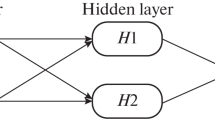Abstract
This paper presents a neural network based decision support system (DSS) for use in concurrently determining cell configuration, operation plans, and complexity requirements of cell control functions. Advanced simulators and neural network technology are used in developing the DSS. Simulation experiments were conducted with many possible combinations of design changes to generate training pairs for a neural network. Complexity of cell control functions required by each design option was assessed, based on operational requirements, and was used to train another neural net. Once both neural networks are properly trained, one network can be used to predict the cell design configuration given a set of desirable cell performance measures, while the other network can be used to identify complexity requirements of the cell control functions by using the output provided by the first network as input to the second neural net. An operation-driven cell design methodology was applied to sequentially predict requirements of both cell configuration and cell control functions from the trained neural networks. This innovative new design methodology was illustrated via a successful implementation exercise in acquiring a real automated manufacturing cell at industrial settings. The exercise proves that such a DSS serves well as an effective tool for cell designers and the management in determining appropriate cell configuration and cell control functions at the design stage.
Similar content being viewed by others
References
F. F. Chen, “Concurrent cell design and cell control system configuration”, in H. R. Parsaei and W. G. Sullivan (eds.)Handbook of Concurrent Engineering, Chapman & Hall, London, pp. 231–247, 1993.
I. T. Franks, L. Martin and N. T. A. Wood, “Discrete cell control”,International Journal of Production Research,28 (9), pp. 1623–1633, 1990.
S. Manivannan and J. Banks, “Real-time control of a manufacturing cell using knowledge based simulation”,Proceedings of the 1991 Winter Simulation Conference, Barry L. Nelson (ed.), pp. 251–259, 1991.
T. O. Bouncher and M. A. Jafari, “Design of a factory floor sequence controller from a high level system specification,”Journal of Manufacturing Systems,11 (6), pp. 401–417, 1992.
H. P. Huang and P. Chang, “Specification, modelling and control of a flexible manufacturing cell”,International Journal of Production Research,30 (10), pp. 2515–2543, 1992.
D. C. Pegden, R. E. Shannon and R. P. Sadowski,Introduction to Simulation using SIMAN, McGraw-Hill, New York, pp. 3–92, 1991.
S. Toure, L. Rabelo and T. Velasco, “Artificial neural networks for flexible manufacturing systems scheduling”,Proceedings of 15th Annual Conference on Computers and Industrial Engineering,24 (1–4), pp. 385–388, 1993.
G. Chryssolouris, M. Lee, J. Pierce and M. Domrose, “Use of neural networks for the design of manufacturing systems”,Journal of Manufacturing Systems,13 (3), pp. 187–194, 1990.
A. J. Vakharia and U. Wemmerlov, “Designing a cellular manufacturing system: a materials flow approach based on opertion sequences”,IIE Transactions,22 (1), pp. 84–96, 1990.
H. M. Huettner and H. J. Steudel, “Analysis of a manufacturing system via spreadsheet analysis, rapid modelling, and manufacturing simulation”,International Journal of Production Research,30 (7), 1699–1714, 1992.
J. G. Fox and H. K. Stephen, “Effective application of simulation in the life cycle of a manufacturing cell project”,Proceedings of the 1991 Winter Simulation Conference, pp. 411–417, 1991.
R. Gujar, P. Desruelle and R. Hammer, “Electronic manufacturing cell design using PC based modelling and simulation tools”,Proceedings of the 1990 Winter Simulation Conference, O. Balci (ed.), pp. 559–563, 1990.
A. S. Kiran, A. Schloffer and D. Hawkins, “An integrated simulation approach to design of flexible manufacturing systems”,Simulation,52 (2), pp. 47–52, 1989.
J. S. Shang and P. R. Tadikamalla, “Output maximization of a CIM system: simulation and statistical approach”,International Journal of Production Research,31 (1), pp. 19–41, 1993.
A. A. Aly and M. Subramaniam, “Design of an FMS decision support system”,International Journal of Production Research,31 (10), pp. 2257–2273, 1993.
R. Suri, “An overview of evaluative models of flexible manufacturing systems”,Proceedings of First ORSA/TIMS Conference on FMS, pp. 1–7, 1984.
C. H. Dagli, P. Poshyanonda and A. Baharami, “Neurocomputing and concurrent engineering”, in H. R. Parsaei and W. G. Sullivan (eds.)Handbook of Concurrent Engineering, Chapman & Hall, London, pp. 465–486, 1993.
H. Cho and R. A. Wysk, “A robust adaptive scheduler for an intelligent workstation controller”,International Journal of Production Research,31 (4), pp. 771–789, 1993.
C. H. Chu, “Manufacturing cell formation by competitive learning”,International Journal of Production Research,31 (4), pp. 829–843, 1993.
T. Velasco and M. R. Rowe, “Back propagation artificial neural networks for the analysis of quality control charts”,Proceedings of 15th Annual Conference on Computers and Industrial Engineering,24 (1–4), pp. 397–400, 1993.
D. B. Seiger and A. B. Badiru, “An artificial neural network case study: prediction versus classification in a manufacturing application”,Proceedings of 15th Annual Conference on Computers and Industrial Engineering,24 (1–4), pp. 381–384, 1993.
M. M. Joseph and F. A. Ahmad, “An expert system for FMS design”,Simulation,8 (5), pp. 201–208, 1987.
J. S. Noble and J. M. A. Tanchoco, “Concurrent design and economic justification in developing a product”,International Journal of Production Research,28 (7), pp. 1225–1238, 1990.
A. Kusiak and K. Park, “Concurrent engineering: decomposing and scheduling of design activities”,International Journal of Production Research,28 (10), pp. 1883–1900, 1990.
ProModelPC Manufacturing Simulation Software — User's Guide, ProModel Corp., 1992.
NeuralWork Professional II/PLUS Reference Manual, Neuralware Inc., 1992.
Author information
Authors and Affiliations
Rights and permissions
About this article
Cite this article
Chen, F.F., Sagi, S.R. Concurrent design of manufacturing cell and control functions: A neural network approach. Int J Adv Manuf Technol 10, 118–130 (1995). https://doi.org/10.1007/BF01179280
Issue Date:
DOI: https://doi.org/10.1007/BF01179280




